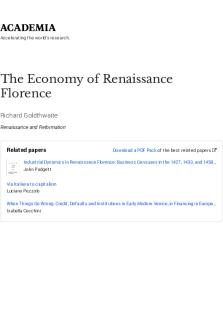THE British Economy Between THE WARS PDF

| Title | THE British Economy Between THE WARS |
|---|---|
| Course | Història Econòmica i de l'empresa |
| Institution | Universitat Pompeu Fabra |
| Pages | 9 |
| File Size | 191.8 KB |
| File Type | |
| Total Downloads | 102 |
| Total Views | 147 |
Summary
Resumen de la lectura del primer seminario ...
Description
THE BRITISH ECONOMY BETWEEN THE WARS 20s and 30s were years of transition, between WWI and WWII, and between the 19 th century (when GB was the first creditor nation, the main manufactured producer and the leading trading nation) and the 1945(when GB the country was overtaken economically). The interwar period is the story of Britain’s loss of economic power. During interwar years growth slowed in almost every industrial country. All market economies were affected: a) 20s were years of political disputes and inflations b) 30s were years of business downturn=The slum in Gb and The Great Depression in EEUU GB decline were not so grave if it is compared to the rest of the world. (Output per worker between 1913-1950) The output per worker rose much more quickly in those countries where the destruction of the war was lower (EEUU, Norway, Sweden, Switzerland and Canada). However, GB output per worker rose faster than Belgium, Denmark, Germany, France and Italy, despite that the comparison was made against Britain. The period between 1913-1950 was a turning point because it is when institution and policies which conditioned economic performance after the WWII took effect: some of those policies had positive effects on economy and contributed to its development, but other of them created problems which had negative effects after WWII. In the table about the output per worker, we can see that GB made it better during WWI and WWII than the rest of Europe, where many hostilities took place, but in the 20s GB economy was worse than the rest of Europe, and it remain under Europe during the 30s but better than in the 20s. The points in which GB growth was distinctive, are periods were policies and factors rendered the economy. The output per worker can be decomposed in two parts (growth of input per worker and growth of the labour productivity) (GDP from eight countries average compared to UK GDP) In the graphic we can see that the two wars had less effect on UK than in the rest of Europe, and the depression of the 30s was shorter and softer. (Annual average rate of growth of net non-residential capital stock per person employed and total factor productivity) In the table, we can see that the foreign investment on the U...
Similar Free PDFs

The Carnatic Wars
- 4 Pages

The British underclass
- 25 Pages

THE British IN ADEN
- 4 Pages

The new British history
- 2 Pages

THE British Museum - summary
- 3 Pages

The Global Economy Notes
- 25 Pages

Comparison Between THE Texts
- 11 Pages

Chapter 22 The Token Economy
- 9 Pages
Popular Institutions
- Tinajero National High School - Annex
- Politeknik Caltex Riau
- Yokohama City University
- SGT University
- University of Al-Qadisiyah
- Divine Word College of Vigan
- Techniek College Rotterdam
- Universidade de Santiago
- Universiti Teknologi MARA Cawangan Johor Kampus Pasir Gudang
- Poltekkes Kemenkes Yogyakarta
- Baguio City National High School
- Colegio san marcos
- preparatoria uno
- Centro de Bachillerato Tecnológico Industrial y de Servicios No. 107
- Dalian Maritime University
- Quang Trung Secondary School
- Colegio Tecnológico en Informática
- Corporación Regional de Educación Superior
- Grupo CEDVA
- Dar Al Uloom University
- Centro de Estudios Preuniversitarios de la Universidad Nacional de Ingeniería
- 上智大学
- Aakash International School, Nuna Majara
- San Felipe Neri Catholic School
- Kang Chiao International School - New Taipei City
- Misamis Occidental National High School
- Institución Educativa Escuela Normal Juan Ladrilleros
- Kolehiyo ng Pantukan
- Batanes State College
- Instituto Continental
- Sekolah Menengah Kejuruan Kesehatan Kaltara (Tarakan)
- Colegio de La Inmaculada Concepcion - Cebu







